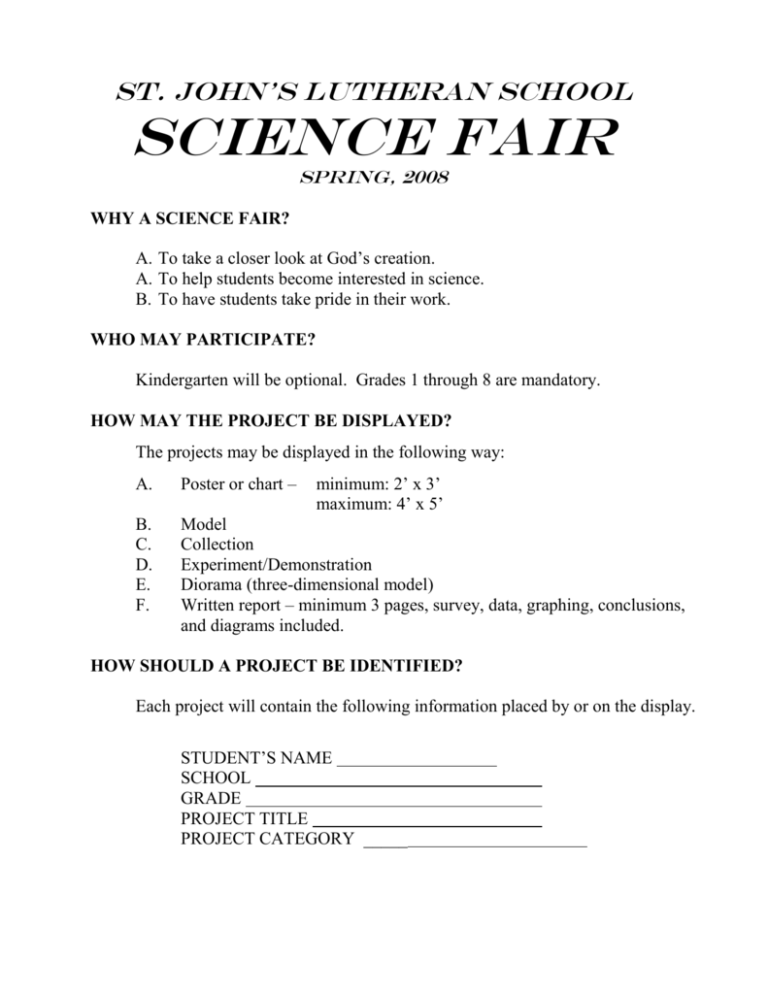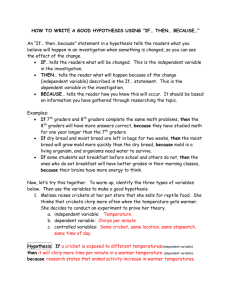File
advertisement

ST. JOHN’S LUTHERAN SCHOOL SCIENCE FAIR SPRING, 2008 WHY A SCIENCE FAIR? A. To take a closer look at God’s creation. A. To help students become interested in science. B. To have students take pride in their work. WHO MAY PARTICIPATE? Kindergarten will be optional. Grades 1 through 8 are mandatory. HOW MAY THE PROJECT BE DISPLAYED? The projects may be displayed in the following way: A. Poster or chart – minimum: 2’ x 3’ maximum: 4’ x 5’ B. C. D. E. F. Model Collection Experiment/Demonstration Diorama (three-dimensional model) Written report – minimum 3 pages, survey, data, graphing, conclusions, and diagrams included. HOW SHOULD A PROJECT BE IDENTIFIED? Each project will contain the following information placed by or on the display. STUDENT’S NAME SCHOOL GRADE PROJECT TITLE PROJECT CATEGORY _____ WHAT GENERAL INFORMATION SHOULD BE INCLUDED WITH EACH PROJECT? A duplicate sheet will be given to each student on April 16 to complete and display with his/her project. The sheet will include questions like: A. B. C. D. E. What is your aim for this project? How did you meet this aim? What materials did you use? What resources did you use? What is the approximate cost for this project? A second sheet will be given to each student to complete and display with his/her project. WHEN SHOULD THE STUDENTS WORK ON THEIR PROJECTS? Most of the work should be done at home. Students will be allowed to work on part of their projects in school if it does not interfere with homework. WHAT AWARDS WILL BE GIVEN? A. B. C. ALL students entering the Science Fair will receive a ribbon. First, second and third place ribbons will be awarded according to the judging. All decisions will be final. ON WHAT WILL THE PROJECT BE JUDGED? The judges will award ribbons according to the following: (if it applies). A. B. C. D. E. F. G. H. Creativity Originality Clear, concise statements Neatness and Workmanship Color and Contrast Completeness Effective display Organization WHAT CAN PARENTS DO TO HELP? Parents can: Help student choose a project. A. Look through science catalogs for ideas. B. Discuss the project with the student. C. Encourage the student. D. Check on the student’s progress to make sure he/she completes the project on time. E. Offer advice and suggestions. Parents cannot do the work for the child. Students cannot plagiarize or use materials directly downloaded from the internet. WHAT CAN THE TEACHERS DO TO HELP? Teachers can: A. Discuss project with student. B. Motivate, guide, and incorporate project into the classroom C. Recommend books and materials. WHERE DO I START? Start looking in: A. Science magazines (Popular Mechanics, National Geographic, etc.) B. Library books C. Science catalogs D. Something that interests you E. Parent or teacher suggestions F. Web sites. WHAT IF I HAVE A QUESTION ABOUT THE SCIENCE FAIR? Ask your teacher or the principal. THE SCIENTIFIC METHOD SCIENCE IS A PROCESS OF SOLVING PROBLEMS. THE METHODS SCIENTISTS USE TO FIND ANSWERS TO PROBLEMS ARE CALLED SCIENTIFIC METHODS. HOW DO YOU FIND NEW FACTS OF SCIENCE? HOW CAN YOU TEST AN IDEA TO SEE IF IT IS ACCEPTABLE? ONE WAY IS TO USE THE FOLLOWING STEPS: 1. MAKE A CLEAR STATEMENT OF THE PROBLEM. Try to understand the problem for which you seek an answer. 2. COLLECT INFORMATION THAT RELATES TO THE PROBLEM. Find as much information as you need from books and other written records. 3. FORM A HYPOTHESIS. Form your own Hypothesis, or “Best Prediction Based on Information.” A Hypothesis is a possible solution for a problem. A Hypothesis is formed after studying the facts and ideas relating to the problem. 4. TEST THE HYPOTHESIS. Design and perform some experiments to see if your hypothesis is acceptable. An experiment is a way of testing a hypothesis. You can test many of your ideas by trying them. 5. ACCEPT OR REJECT THE HYPOTHESIS. To accept or reject your hypothesis, study the results obtained in experiments, in some cases, you may be forced to a conclusion that your hypothesis was incorrect, this does not mean that your work was wrong or useless… It means that you learned what the answer must NOT be. (Taken from, PRINCIPALS OF SCIENCE, Charles E. Merrill Publishing Co. 1979: pages 6 & 7. SAMPLE CATEGORY:EXPERIMENTATION MATERIALS: QUESTION: Wheat Bread (Without Preservatives) White Bread (With Preservatives) What conditions are best for growing mold? RESEARCH: Black mold is a common bread mold. So are the following molds: Blue Mold, Green Mold, and Water Molds. Molds develop from spores. Molds have no chlorophyll and therefore, are not capable of making their own food. Molds must therefore grow on things which provide them with food. Molds are not useless because they can break up organisms and waste matter, can fertilize soil and can even be made to serve man in medicine. HYPOTHESIS: Covered wheat bread without preservatives will mold faster than bread that has preservatives in it. EXPERIMENT: My experiment was started April 4th. I set up eight pieces of bread under different conditions. Bread #1 White Bread Bread #2 Bread #3 Wheat Bread Wheat Bread Bread #4 Bread #5 White Bread Wheat Bread Bread #6 White Bread Bread #7 White Bread Bread # 8 Wheat Bread In a sunny place, covered In a dark place, covered In a sunny place, covered In a dark place, covered In a sunny place, uncovered In a dark place, uncovered In a sunny place, uncovered In a dark place, uncovered OBSERVATION: April 14: First mold started on covered wheat bread, which was in a dark place. April 16: White bread which was in a dark place started growing mold. April 18: Wheat and white bread which were in the sun started growing mold. I observed that none of the bread left in the open air molded. (They became extremely hard also.) (Observations should be kept in a log book which gives exact time observation on the process of experimentations took place. This information will be used form making charts, graphs, statements on the science backdrop you choose to set up, and in arriving at your final conclusion.) CONCLUSION: Bread needs moisture and darkness to grow mold. The preservatives did not seem to slow the process of mold growth.






